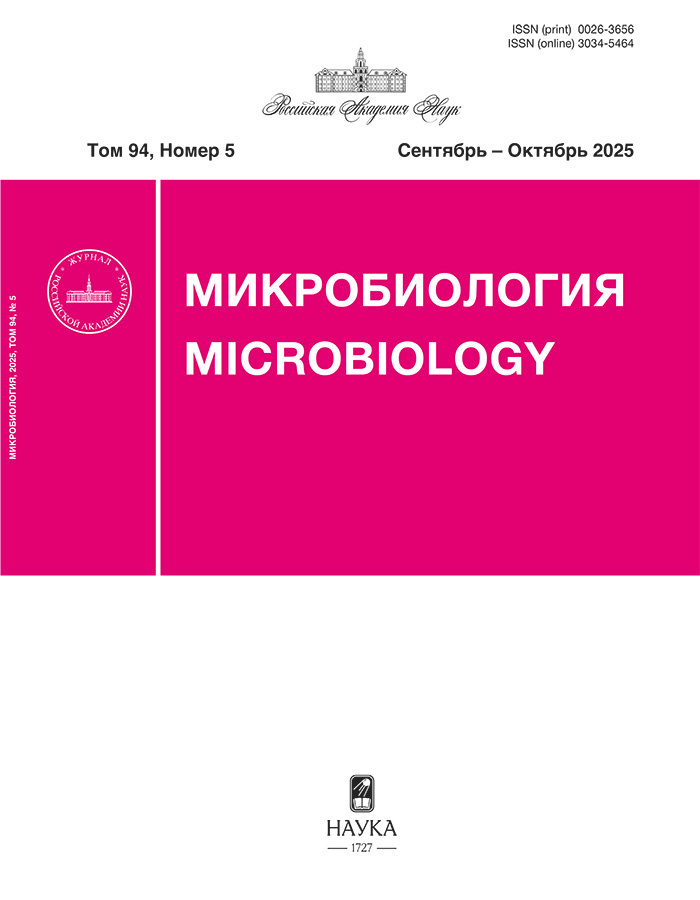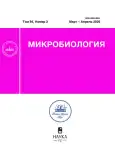Effect of silver nanoclusters on the copper resistance of Achromobacter insolitus LCu2
- Authors: Burygin G.L.1,2,3, Astankova A.S.1,2, Chumakov D.S.1, Kryuchkova Y.V.1,3
-
Affiliations:
- Saratov Scientific Centre of the Russian Academy of Sciences
- Saratov State University
- Saratov State University of Genetics, Biotechnology, and Engineering named after N.I. Vavilov
- Issue: Vol 94, No 2 (2025)
- Pages: 195–198
- Section: SHORT COMMUNICATIONS
- URL: https://gynecology.orscience.ru/0026-3656/article/view/680841
- DOI: https://doi.org/10.31857/S0026365625020081
- ID: 680841
Cite item
Abstract
Abstract. In this work, the resistance of Achromobacter insolitus LCu2 cells to copper (II) was reduced by adding 1 μM silver nanoclusters to the culture medium: the maximum tolerable concentration decreased by 4 times, the minimum inhibitory concentration – by 25 times. It is assumed that nanoclusters disrupt the functioning of the copper (II) efflux system through binding to the CusC protein, which leads to a partial loss of the ability of bacteria to export excess copper (II) cations from cells.
Keywords
Full Text
About the authors
G. L. Burygin
Saratov Scientific Centre of the Russian Academy of Sciences; Saratov State University; Saratov State University of Genetics, Biotechnology, and Engineering named after N.I. Vavilov
Author for correspondence.
Email: burygingl@gmail.com
Institute of Biochemistry and Physiology of Plants and Microorganisms
Russian Federation, Saratov, 410049; Saratov, 410012; Saratov, 410012A. S. Astankova
Saratov Scientific Centre of the Russian Academy of Sciences; Saratov State University
Email: burygingl@gmail.com
Institute of Biochemistry and Physiology of Plants and Microorganisms
Russian Federation, Saratov, 410049; Saratov, 410012D. S. Chumakov
Saratov Scientific Centre of the Russian Academy of Sciences
Email: burygingl@gmail.com
Institute of Biochemistry and Physiology of Plants and Microorganisms
Russian Federation, Saratov, 410049Y. V. Kryuchkova
Saratov Scientific Centre of the Russian Academy of Sciences; Saratov State University of Genetics, Biotechnology, and Engineering named after N.I. Vavilov
Email: burygingl@gmail.com
Institute of Biochemistry and Physiology of Plants and Microorganisms
Russian Federation, Saratov, 410049; Saratov, 410012References
- Abramson J., Adler J., Dunger J., Evans R., Green T., Pritzel A., Ronneberger O., Willmore L., Ballard A. J., Bambrick J., Bodenstein S. W., Evans D. A., Chia-Chun Hung, O’Neill M., Reiman D., Tunyasuvunakool K., Wu Z., Žemgulytė A., Arvaniti E., Beattie C., Bertolli O., Bridgland A., Cherepanov A., Congreve M., Cowen-Rivers A.I., Cowie A., Figurnov M., Fuchs F. B., Gladman H., Jain R., Khan Y. A., Low C. M.R., Perlin K., Potapenko A., Savy P., Singh S., Stecula A., Thillaisundaram A., Tong C., Yakneen S., Zhong E. D., Zielinski M., Žídek A., Bapst V., Kohli P., Jaderberg M., Hassabis D., Jumper J. M. Accurate structure prediction of biomolecular interactions with AlphaFold 3 // Nature. 2024. V. 630. P. 493–500.
- Cervantes C., Gutierrez-Corona F. Copper resistance mechanisms in bacteria and fungi // FEMS Microbiol. Rev. 1994. V. 14. P. 121–137.
- Draviana H. T., Fitriannisa I., Khafid M., Krisnawati D. I., Widodo, Lai C. H., Fan Y. J., Kuo T. R. Size and charge effects of metal nanoclusters on antibacterial mechanisms // J. Nanobiotechnol. 2023. V. 21. Art. 428. https://doi.org/10.1186/s12951-023-02208-3
- Franke S., Grass G., Rensing C., Nies D. H. Molecular analysis of the copper-transporting efflux system CusCFBA of Escherichia coli // J. Bacteriol. 2003. V. 185. P. 3804–3812.
- Hernández-Montes G., Argüello J. M., Valderrama B. Evolution and diversity of periplasmic proteins involved in copper homeostasis in gamma proteobacteria // BMC Microbiol. 2012. V. 12. Art. 249. https://doi.org/10.1186/1471-2180-12-249
- Kryuchkova Y. V., Neshko A. A., Gogoleva N. E., Balkin A. S., Safronova V. I., Kargapolova K. Y., Shagimardanova E. I., Gogolev Y. V., Burygin G. L. Genomics and taxonomy of the glyphosate-degrading, copper-tolerant rhizospheric bacterium Achromobacter insolitus LCu2 // Antonie van Leeuwenhoek. 2024. V. 117. Art. 105. https://doi.org/10.1007/s10482-024-01989-3
- Magnani D., Solioz M. How bacteria handle copper // Molecular microbiology of heavy metals. Microbiology monographs. V. 6. / Eds. Nies D. H., Silver S. Berlin, Heidelberg: Springer Berlin Heidelberg, 2007. P. 259–285. https://doi.org/10.1007/7171_2006_081
- Tkachenko O. V., Evseeva N. V., Boikova N. V., Matora L. Y., Burygin G. L., Lobachev Y. V., Shchyogolev S. Y. Improved potato microclonal reproduction with the plant growth-promoting rhizobacteria Azospirillum // Agron. Sustain. Dev. 2015. V. 35. P 1167–1174.
- Tumskiy R., Khlebtsov B., Tumskaia A., Evstigneeva S., Antoshkina E., Zakharevich A., Khlebtsov N. G. Enhanced antibacterial activity of novel fluorescent glutathione-capped Ag nanoclusters // Int. J. Mol. Sci. 2023. V. 24. Art. 8306. https://doi.org/10.3390/ijms24098306
Supplementary files









